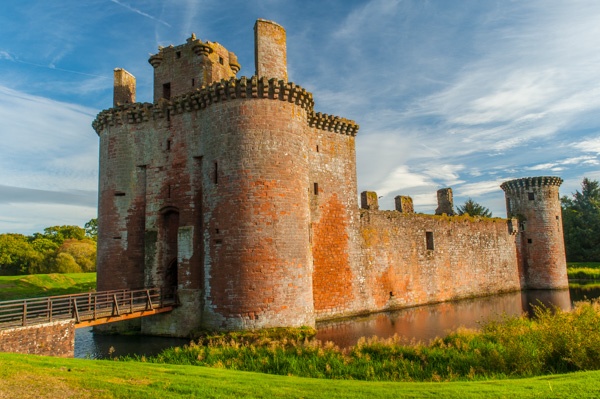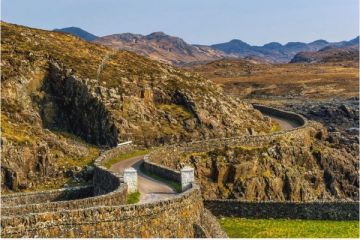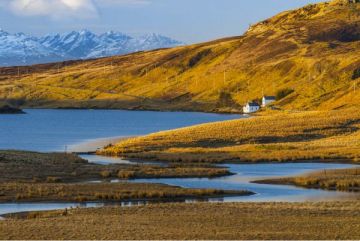
Dumfries and Galloway faces England across the Solway Firth. For centuries armies marched back and forth across the lowland region where the rivers Eden and Liddel Water empty into the Solway. Even after the area became more settled eloping couples crossed the border to be married across the blacksmith's anvil at Gretna Green.
Today things are a lot more peaceful, and today's visitor can enjoy one of the most beautiful areas of lowland Scotland.
Medieval Castles
Close to the border are reminders of Scotland's interminable conflicts with England. At Caerlaverock a magnificent triangular castle stands within a water-filled moat, while Lochmaben Castle, near Lockerbie, is said to be the birthplace of Robert the Bruce. Near Thornhill, the roofless ruins of 13th century Morton Castle stand in magnificent countryside overlooking a small loch.

Near Morton Castle is Drumlanrig, a 18th-century stately home on the foundations of a medieval fortress. Drumlanrig is home to the Dukes of Buccleuch and Queensberry, who count among their ancestors Sir William Douglas, who fought beside Robert Bruce in the Wars of Independence.
Near the town of Castle Douglas stands Threave Castle, set on an island and accessible only by boat when the water is calm. The castle stands near the National Trust for Scotland's Threave estate, known for its superb gardens and its resident population of rare bats.
The county town of Dumfries has strong links to poet Robert Burns, who lived and died here. Burns' imposing mausoleum stands near the house where he died, which now serves as a museum to Scotland's national poet. South of Dumfries is Sweetheart Abbey, a ruined 13th-century monastery, the last Cistercian abbey founded in Scotland. Near the Abbey is New Abbey Corn Mill, a restored 18th-century oatmeal mill.
Further west along the Solway Firth you come to Kirkcudbright, long a favourite destination for artists, and the setting for Five Red Herrings, one of Dorothy Sayer's most popular mystery novels. Beyond Kirkcudbright are a series of historic tower houses, including Carsluith Castle, Cardoness Castle, and Sorbie Tower, a late 16th-century house set in a wooded copse. Sorbie Tower stands in the north of the Isle of Whithorn, known for its machar, or grasslands.

Ancient Christianity
The town of Whithorn is known today for its numerous bookshops, but it has a history going back to the 5th century, when St Ninian founded the first known Christian site in Scotland. You can explore the ruins of Whithorn Priory and see carved stones found on the site in a small museum beside a ruined medieval church. On the coast at Physgill is St Ninian's Cave, used by 6th and 7th-century hermits associated with Ninian's priory at Whithorn.
Even more ancient are the Drumtroddan standing stones, and nearby flat rocks marked with ancient cup and ring symbols. South of Stranraer is Logan Botanic Garden, a Southern Hemisphere garden on the Rinns of Galloway, where exotic plants thrive in a unique micro-climate, warmed by the Gulf Stream.
I've visited Dumfries and Galloway numerous times, and even as I write this I'm planning my next trip back. It truly is one of Scotland's least known ares, yet one filled with historic interest and magnificent scenery.
If I was pressed to name my favourite historic attractions in Dumfries and Galloway I'd choose,
but in truth, I could easily name 15-20 more!








